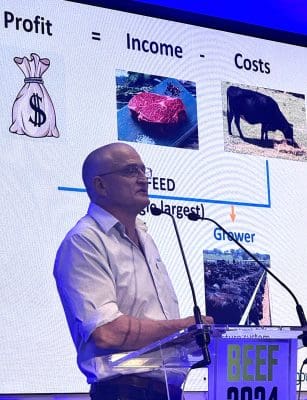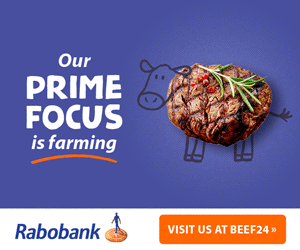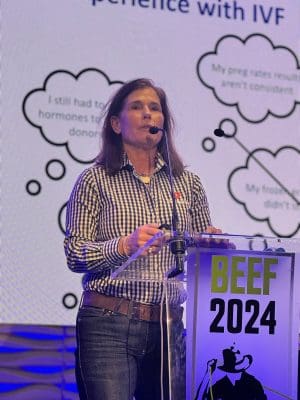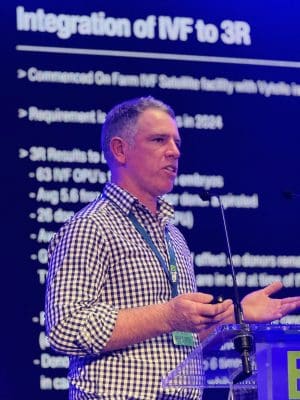SUSTAINABILITY has been a dominant theme across many of the industry seminars conducted on day two at Beef 2024. The role of breeding and genetic improvement within the context of sustainable beef production was a focus of today’s breeding technologies seminar hosted by international breeding company Vytelle.

David Johnstone
Leading the session, respected beef industry researcher Dr David Johnston from the Animal Genetics and Breeding Unit said all beef businesses were faced with increased costs. And that the greatest cost for any system was the cost of feed -specifically, how much feed an animal needs to consume to achieve a kilogram of liveweight gain or other unit of production.
Highlighting that many producers have yet to truly factor into their breeding systems the impact of feed cost on production, Dr Johnston demonstrated that using current breeding data such as Breedplan Net Feed Intake (NFI) EBVs, producers could actively select for cattle that would consume less feed per unit of production.
An example provided by Dr Johnston showed two bulls with an NFI difference of 1.4. This means the difference would result in the progeny of the bull with the more favourable, (Lower NFI number) consuming 1.4kg less feed per day, for the same weightgain.
To some people, this may not seem to be a significant difference. However as a steer entered a 270-day feeding program, that equates to consuming 380kg less feed over the feeding period. In the case of a pen of 20 steers, that difference would see the feedlot operator saving around 7.6 tonnes of feed, while still achieving the same expected rates of daily gain.
 Although there are some producers who may see the value of including NFI in their breeding objectives, there are still many other bull breeders and beef producers who have yet to formally place a cost of feed into their breeding objectives.
Although there are some producers who may see the value of including NFI in their breeding objectives, there are still many other bull breeders and beef producers who have yet to formally place a cost of feed into their breeding objectives.
While noting the need to place a cost of feed within individual breeding programs, Dr Johnston also highlighted that current $Index values, published by most breeds using BreedPlan, actually have a cost of feed included in that calculation.
He noted that for those producers using $Index values as part of their selection process, this offers a positive progression towards selection for more efficient and sustainable breeding cattle.
Increasing the rate of genetic gain, particularly on these and other traits that influence sustainable production, was also a subject of discussion in the seminar.
Genetic progress is a feature not only of selection intensity, but also on how fast these genetics can be utilised in breeding herds.

Lisa Rumsfeld
As noted by Vytelle’s Lisa Rumsfeld, “the aim is to replicate the right genetics at a faster rate. The long-term goal is to ensure viable production of protein over successive generations.”
Artificial breeding technologies offered a clear way of achieving this increased rate of use of more valuable genetics. While the focus of the seminar session was on traits associated with feed efficiency, it was also noted that superior animals were those with the traits most suited for particular breeding objectives, which may be traits associated with growth or reproductive efficiency.
IVF, a process that involves identifying and selecting genetically superior cattle and collection of oocytes before taking these to a lab for embryo development, has become an increasingly more effective and common method of artificial breeding.
Ms Rumsfeld noted that 80pc of all embryos developed are now the result of IVF rather than traditional embryo technologies.
 Some of the reasons behind this rapid take-up of the technology were given by Tamworth seedstock producer Geoff Birchnall of 3R livestock, who said that IVF not only allowed more scalable production with a limited labour resource (as there was no requirement for injections or prior treatment), but also that cows could be kept in their normal seasonal pattern and not have to be held over to join in a natural mating after flushing.
Some of the reasons behind this rapid take-up of the technology were given by Tamworth seedstock producer Geoff Birchnall of 3R livestock, who said that IVF not only allowed more scalable production with a limited labour resource (as there was no requirement for injections or prior treatment), but also that cows could be kept in their normal seasonal pattern and not have to be held over to join in a natural mating after flushing.
This meant that not only was there less disruption in the management of the herd, but ultimately those donor cows would also still produce a natural born calf and therefore productivity was also maintained or improved.
In the case of 3R livestock, Geoff Birchnall said the inclusion of IVF into his program offered result that were “better than hoped-for, and was ultimately resulting in more productivity for less labour.”
As a practical take-home from the session, producers were encouraged to think about the goals they have for their production system, not overlooking the need to include feed costs and select for greater efficiency.
In doing so, these efforts may help identify groups of females that have greater genetic merit for chosen traits. The accessibility of processes such as IVF was presented as a viable way for cattle breeders, including commercial producers, to replicate and use those genes at a faster rate within a herd and so closer to meeting of exceeding breeding goals.

Alastair Rayner
Alastair Rayner is the Principal of RaynerAg, an agricultural advisory service based in NSW. RaynerAg is affiliated with BJA Stock & Station Agents. He regularly lists and sell cattle for clients as well attending bull sales to support client purchases. Alastair provides pre-sale selections and classifications for seedstock producers in NSW, Qld, and Victoria. He can be contacted here or through his website www.raynerag.com.au
